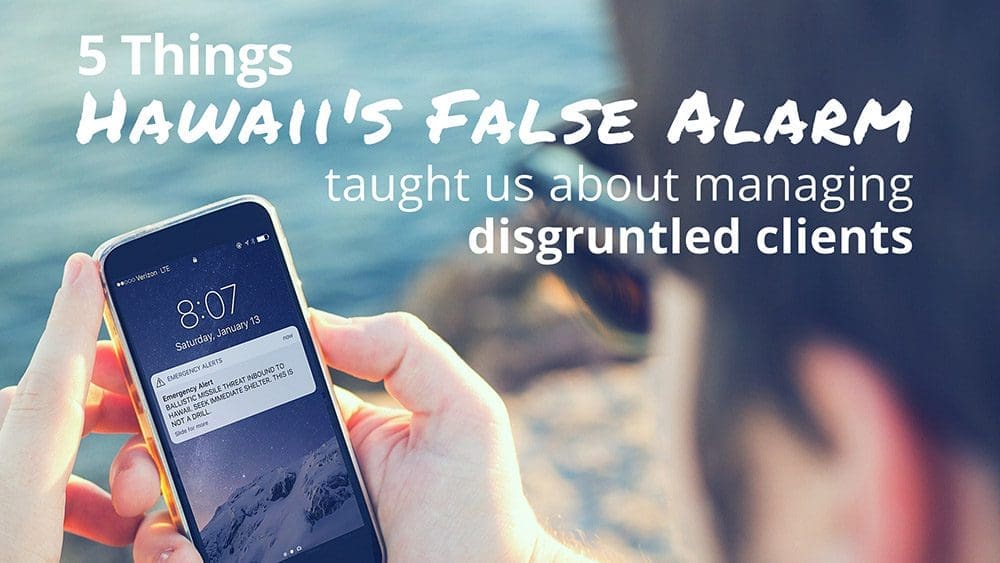5 Lessons Hawaii’s false alarm taught us about damage control

What does the epic fail of the emergency alert system in Hawaii have to do with your business? More than you might think. Read on.
Just in case you were on a deserted island for the last week and didn’t hear about this crazy story…
On Saturday, January 13th, people living and vacationing in Hawaii got the scare of a lifetime when an emergency alert warning was mistakenly sent, warning them to “seek immediate shelter” from an inbound ballistic missile threat. For 38 minutes, people lived in a state of hysteria and panic until they were finally informed that the alert was a false alarm, sent in error by an employee of the Hawaii Emergency Management System who, apparently, “pushed the wrong button.”
Um, what?
(P.S. – If you live in Hawaii and went through this, please accept my apologies for this flashback moment.)
Despite obvious relief at avoiding nuclear destruction, residents were left feeling furious, wondering how HEMA could have let this happen, and why the heck it took 38 minutes to send a follow-up mobile notification recalling the threat.
While a discussion of the political circumstances surrounding this mishap extend well beyond the scope of this blog, I couldn’t help but reflect on the way the situation was handled by state officials.
In business, when we talk about “crisis management,” we usually aren’t referring to something as extreme as communications related to a potential nuclear attack. However, even if a “crisis” in your business is as simple as a bad online review or an angry client, there is still much to be learned from this situation. Below are 5 key takeaways.
5 Lessons the False Alarm in Hawaii Taught Us About Managing Disgruntled Clients
1. Have a plan. The slow, and seemingly disorganized, response by authorities in Hawaii highlights why it is so critically important to have a plan in place for doing “damage control” when undesireable situations arise. According to the Washington Post, HEMA spokesman Richard Rapoza said that “part of what worsened the situation Saturday was that there was no system in place at the state emergency agency for correcting the error. The state agency had standing permission through FEMA to use civil warning systems to send out the missile alert — but not to send out a subsequent false alarm alert.”
When a crisis hits your office – such as an extremely unhappy client – do you have a step-by-step plan in place to handle the situation? Have you gone through the plan with your team, so everyone knows their role, keeps their cool, and can make smart and quick decisions? Don’t lose great clients – and potential referral sources – due to a lack of planning and training.
2. Resolve the issue as quickly as possible. I can only imagine that the 38 minutes that went by between alerts sent by HEMA probably felt more like 38 years to the people thinking they were about to die at any moment. Although the situations you’re more likely to face are probably not a matter of life or death, if you have a dissatisfied client do your best to resolve the situation as quickly as possible. Keep the client in the loop as you make progress to the solution.
3. Have empathy. As discussed in my upcoming book, Radical Relevance, empathy is one of the keys to crafting relevant messaging that resonates with your prospects and clients. Although you may feel that their perspective on the situation is way off base, that doesn’t really matter. First, you have to show that you understand and respect their position, whatever it may be. As you learn more about it, and they feel heard, you can begin to work on changing their perspective (if appropriate).
4. Don’t get defensive, make excuses, or argue. You will never win an argument with a client. Even if you win the battle, you’ll probably lose the war (the client will walk). Only after you have completely heard the client’s position, and have come to a solution that pleases them, should you tell them some of the reasons that contributed to the problem. Doing this too soon in the process will appear as if you are making excuses and not taking responsibility.
5. Say “I’m sorry.” Last, but certainly not least… just apologize (and be genuine!) If there is one thing that HEMA has done right, it’s this. They have repeatedly apologized and admitted that they made a mistake. However, even if you feel like you did nothing wrong, it’s important to understand that saying “I’m sorry” is not admitting fault. You’re sorry they are upset, you’re sorry they are frustrated, you’re sorry they are not happy with something you, or someone in your company, did. Saying “I’m sorry” is an expression of empathy that begins to diffuse any negativity they may be holding.
Listen, it’s inevitable that even the most well-run businesses will have disgruntled clients from time to time. No person, or business, is perfect. And while you should certainly do everything you can to keep your clients from becoming dissatisfied in the first place, the key to preserving the relationship (and potential referral relationships down the road) is how you react to the situation.





